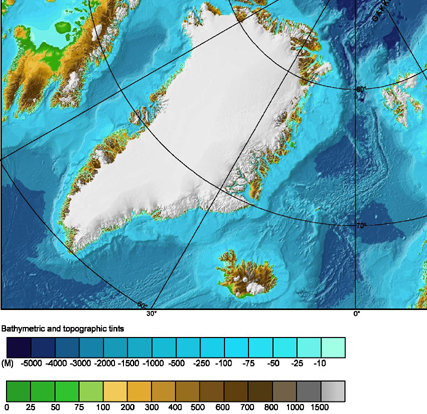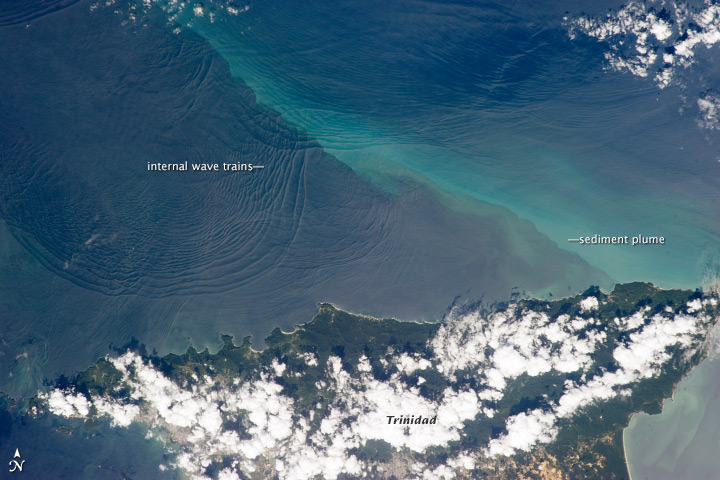|
Ocean Acoustic Tomography
Ocean acoustic tomography is a technique used to measure temperatures and currents over large regions of the ocean. On ocean basin scales, this technique is also known as acoustic thermometry. The technique relies on precisely measuring the time it takes sound signals to travel between two instruments, one an acoustic source and one a receiver, separated by ranges of . If the locations of the instruments are known precisely, the measurement of time-of-flight can be used to infer the speed of sound, averaged over the acoustic path. Changes in the speed of sound are primarily caused by changes in the temperature of the ocean, hence the measurement of the travel times is equivalent to a measurement of temperature. A change in temperature corresponds to about change in sound speed. An oceanographic experiment employing tomography typically uses several source-receiver pairs in a moored array that measures an area of ocean. Motivation Seawater is an electrical condu ... [...More Info...] [...Related Items...] OR: [Wikipedia] [Google] [Baidu] |
Tomography Atlantic
Tomography is imaging by sections or sectioning that uses any kind of penetrating wave. The method is used in radiology, archaeology, biology, atmospheric science, geophysics, oceanography, plasma physics, materials science, cosmochemistry, astrophysics, quantum information, and other areas of science. The word ''tomography'' is derived from Ancient Greek τόμος ''tomos'', "slice, section" and γράφω ''graphō'', "to write" or, in this context as well, "to describe." A device used in tomography is called a tomograph, while the image produced is a tomogram. In many cases, the production of these images is based on the mathematical procedure tomographic reconstruction, such as X-ray computed tomography technically being produced from multiple projectional radiographs. Many different reconstruction algorithms exist. Most algorithms fall into one of two categories: filtered back projection (FBP) and iterative reconstruction (IR). These procedures give inexact results: th ... [...More Info...] [...Related Items...] OR: [Wikipedia] [Google] [Baidu] |
Rays Test
Ray may refer to: Fish * Ray (fish), any cartilaginous fish of the superorder Batoidea * Ray (fish fin anatomy), a bony or horny spine on a fin Science and mathematics * Ray (geometry), half of a line proceeding from an initial point * Ray (graph theory), an infinite sequence of vertices such that each vertex appears at most once in the sequence and each two consecutive vertices in the sequence are the two endpoints of an edge in the graph * Ray (optics), an idealized narrow beam of light * Ray (quantum theory), an equivalence class of state-vectors representing the same state Arts and entertainment Music * The Rays, an American musical group active in the 1950s * Ray (musician), stage name of Japanese singer Reika Nakayama (born 1990) * Ray J, stage name of singer William Ray Norwood, Jr. (born 1981) * ''Ray'' (Bump of Chicken album) * ''Ray'' (Frazier Chorus album) * ''Ray'' (L'Arc-en-Ciel album) * ''Rays'' (Michael Nesmith album) (former Monkee) * ''Ray'' (soundtrack), a ... [...More Info...] [...Related Items...] OR: [Wikipedia] [Google] [Baidu] |
Oceanic Gyre
In oceanography, a gyre () is any large system of circulating ocean currents, particularly those involved with large wind movements. Gyres are caused by the Coriolis effect; planetary vorticity, horizontal friction and vertical friction determine the circulatory patterns from the ''wind stress curl'' (torque). ''Gyre'' can refer to any type of vortex in an atmosphere or a sea, even one that is human-created, but it is most commonly used in terrestrial oceanography to refer to the major ocean systems. Major gyres The following are the five most notable ocean gyres:The five most notable gyres PowerPoint Presentation * * ... [...More Info...] [...Related Items...] OR: [Wikipedia] [Google] [Baidu] |
Greenland Sea
The Greenland Sea is a body of water that borders Greenland to the west, the Svalbard archipelago to the east, Fram Strait and the Arctic Ocean to the north, and the Norwegian Sea and Iceland to the south. The Greenland Sea is often defined as part of the Arctic Ocean, sometimes as part of the Atlantic Ocean. However, definitions of the Arctic Ocean and its seas tend to be imprecise or arbitrary. In general usage the term "Arctic Ocean" would exclude the Greenland Sea. In oceanographic studies the Greenland Sea is considered part of the Nordic Seas, along with the Norwegian Sea. The Nordic Seas are the main connection between the Arctic and Atlantic oceans and, as such, could be of great significance in a possible shutdown of thermohaline circulation. In oceanography the Arctic Ocean and Nordic Seas are often referred to collectively as the "Arctic Mediterranean Sea", a marginal sea of the Atlantic. The sea has Arctic climate with regular northern winds and temperatures rare ... [...More Info...] [...Related Items...] OR: [Wikipedia] [Google] [Baidu] |
Abyssal Plain
An abyssal plain is an underwater plain on the deep ocean floor, usually found at depths between and . Lying generally between the foot of a continental rise and a mid-ocean ridge, abyssal plains cover more than 50% of the Earth's surface. They are among the flattest, smoothest, and least explored regions on Earth. Abyssal plains are key geologic elements of oceanic basins (the other elements being an elevated mid-ocean ridge and flanking abyssal hills). The creation of the abyssal plain is the result of the spreading of the seafloor (plate tectonics) and the melting of the lower oceanic crust. Magma rises from above the asthenosphere (a layer of the upper mantle), and as this basaltic material reaches the surface at mid-ocean ridges, it forms new oceanic crust, which is constantly pulled sideways by spreading of the seafloor. Abyssal plains result from the blanketing of an originally uneven surface of oceanic crust by fine-grained sediments, mainly clay and silt. Much of ... [...More Info...] [...Related Items...] OR: [Wikipedia] [Google] [Baidu] |
Woods Hole Oceanographic Institution
The Woods Hole Oceanographic Institution (WHOI, acronym pronounced ) is a private, nonprofit research and higher education facility dedicated to the study of marine science and engineering. Established in 1930 in Woods Hole, Massachusetts, it is the largest independent oceanographic research institution in the U.S., with staff and students numbering about 1,000. Constitution The Institution is organized into six departments, the Cooperative Institute for Climate and Ocean Research, and a marine policy center. Its shore-based facilities are located in the village of Woods Hole, Massachusetts, United States and a mile and a half away on the Quissett Campus. The bulk of the Institution's funding comes from grants and contracts from the National Science Foundation and other government agencies, augmented by foundations and private donations. WHOI scientists, engineers, and students collaborate to develop theories, test ideas, build seagoing instruments, and collect data in di ... [...More Info...] [...Related Items...] OR: [Wikipedia] [Google] [Baidu] |
Scripps Institution Of Oceanography
The Scripps Institution of Oceanography (sometimes referred to as SIO, Scripps Oceanography, or Scripps) in San Diego, California, US founded in 1903, is one of the oldest and largest centers for ocean and Earth science research, public service, undergraduate and graduate training in the world. Hundreds of ocean and Earth scientists conduct research with the aid of oceanographic research vessels and shorebased laboratories. Its Old Scripps Building is a U.S. National Historic Landmark. SIO is a division of the University of California San Diego (UCSD). The public explorations center of the institution is the Birch Aquarium at Scripps. Since becoming part of the University of California in 1912, the institution has expanded its scope to include studies of the physics, chemistry, geology, biology, and climate of Earth. Margaret Leinen took office as Vice Chancellor for Marine Sciences, Director of Scripps Institution of Oceanography, and Dean of the Graduate School of Marine ... [...More Info...] [...Related Items...] OR: [Wikipedia] [Google] [Baidu] |
Antipodes
In geography, the antipode () of any spot on Earth is the point on Earth's surface diametrically opposite to it. A pair of points ''antipodal'' () to each other are situated such that a straight line connecting the two would pass through Earth's center. Antipodal points are as far away from each other as possible. The North and South Poles are antipodes of each other. In the Northern Hemisphere, "the Antipodes" may refer to Australia and New Zealand, and Antipodeans to their inhabitants. Geographically, the antipodes of Britain and Ireland are in the Pacific Ocean, south of New Zealand. This gave rise to the name of the Antipodes Islands of New Zealand, which are close to the antipode of London. With the exception of a part of the Perth metropolitan area near Baldivis and Rockingham that is antipodal to Bermuda, the antipodes of Australia are in the North Atlantic Ocean, while parts of Spain, Portugal, France and Morocco are antipodal to New Zealand. Approxima ... [...More Info...] [...Related Items...] OR: [Wikipedia] [Google] [Baidu] |
Climate Change
In common usage, climate change describes global warming—the ongoing increase in global average temperature—and its effects on Earth's climate system. Climate change in a broader sense also includes previous long-term changes to Earth's climate. The current rise in global average temperature is more rapid than previous changes, and is primarily caused by humans burning fossil fuels. Fossil fuel use, deforestation, and some agricultural and industrial practices increase greenhouse gases, notably carbon dioxide and methane. Greenhouse gases absorb some of the heat that the Earth radiates after it warms from sunlight. Larger amounts of these gases trap more heat in Earth's lower atmosphere, causing global warming. Due to climate change, deserts are expanding, while heat waves and wildfires are becoming more common. Increased warming in the Arctic has contributed to melting permafrost, glacial retreat and sea ice loss. Higher temperatures are also causin ... [...More Info...] [...Related Items...] OR: [Wikipedia] [Google] [Baidu] |
Internal Waves
Internal waves are gravity waves that oscillate within a fluid medium, rather than on its surface. To exist, the fluid must be stratified: the density must change (continuously or discontinuously) with depth/height due to changes, for example, in temperature and/or salinity. If the density changes over a small vertical distance (as in the case of the thermocline in lakes and oceans or an atmospheric inversion), the waves propagate horizontally like surface waves, but do so at slower speeds as determined by the density difference of the fluid below and above the interface. If the density changes continuously, the waves can propagate vertically as well as horizontally through the fluid. Internal waves, also called internal gravity waves, go by many other names depending upon the fluid stratification, generation mechanism, amplitude, and influence of external forces. If propagating horizontally along an interface where the density rapidly decreases with height, they are specifically c ... [...More Info...] [...Related Items...] OR: [Wikipedia] [Google] [Baidu] |
Ocean Current
An ocean current is a continuous, directed movement of sea water generated by a number of forces acting upon the water, including wind, the Coriolis effect, breaking waves, cabbeling, and temperature and salinity differences. Depth contours, shoreline configurations, and interactions with other currents influence a current's direction and strength. Ocean currents are primarily horizontal water movements. An ocean current flows for great distances and together they create the global conveyor belt, which plays a dominant role in determining the climate of many of Earth’s regions. More specifically, ocean currents influence the temperature of the regions through which they travel. For example, warm currents traveling along more temperate coasts increase the temperature of the area by warming the sea breezes that blow over them. Perhaps the most striking example is the Gulf Stream, which makes northwest Europe much more temperate for its high latitude compared to other ... [...More Info...] [...Related Items...] OR: [Wikipedia] [Google] [Baidu] |
Argo (oceanography)
Argo is an international program that uses profiling floats to observe temperature, salinity, currents, and, recently, bio-optical properties in the Earth's oceans; it has been operational since the early 2000s. The real-time data it provides is used in climate and oceanographic research. A special research interest is to quantify the ocean heat content (OHC). The Argo fleet consists of almost 4000 drifting "Argo floats" (as profiling floats used by the Argo program are often called) deployed worldwide. Each float weighs 20–30 kg. In most cases probes drift at a depth of 1000 metres (the so-called parking depth) and, every 10 days, by changing their buoyancy, dive to a depth of 2000 metres and then move to the sea-surface, measuring conductivity and temperature profiles as well as pressure. From these, salinity and density can be calculated. Seawater density is important in determining large-scale motions in the ocean. Average current velocities at 1000 ... [...More Info...] [...Related Items...] OR: [Wikipedia] [Google] [Baidu] |


.jpg)


